Degree Show Catalogue 2023



Welcome to the School of Design 2023 Postgraduate exhibition of work in Fashion & Textile Design, Graphics/Illustration/Photography, Interior Design and Product Design Engineering.
We commend this year’s graduates on their hard work, congratulating them on their achievements. Design probes and challenges through lateral and critical thinking. It has the power to improve the quality of life and enrich our culture and society and in this exhibition, you see the evidence of these approaches, now manifest.
To our visitors, thank you for visiting our Postgraduate show. We hope you are challenged and excited by what you see exhibited across the magnificent Reid building. Enjoy your visit and explorations, knowing more can be found on our accompanying digital showcase, where more information can be found about each student and their work.
To all our staff, including academic, technical, admin and support roles, my sincerest thanks for all your hard work evident in this excellent exhibition and over the past year.
To our graduating students, we wish you every success in your future careers and ask you stay in touch with us and the Glasgow School of Art as an important alumnus of our school.
Best wishes
 Professor Stephen Bottomley MPhil RCA, MA Design, BA Hons Head of the School of Design
Professor Stephen Bottomley MPhil RCA, MA Design, BA Hons Head of the School of Design
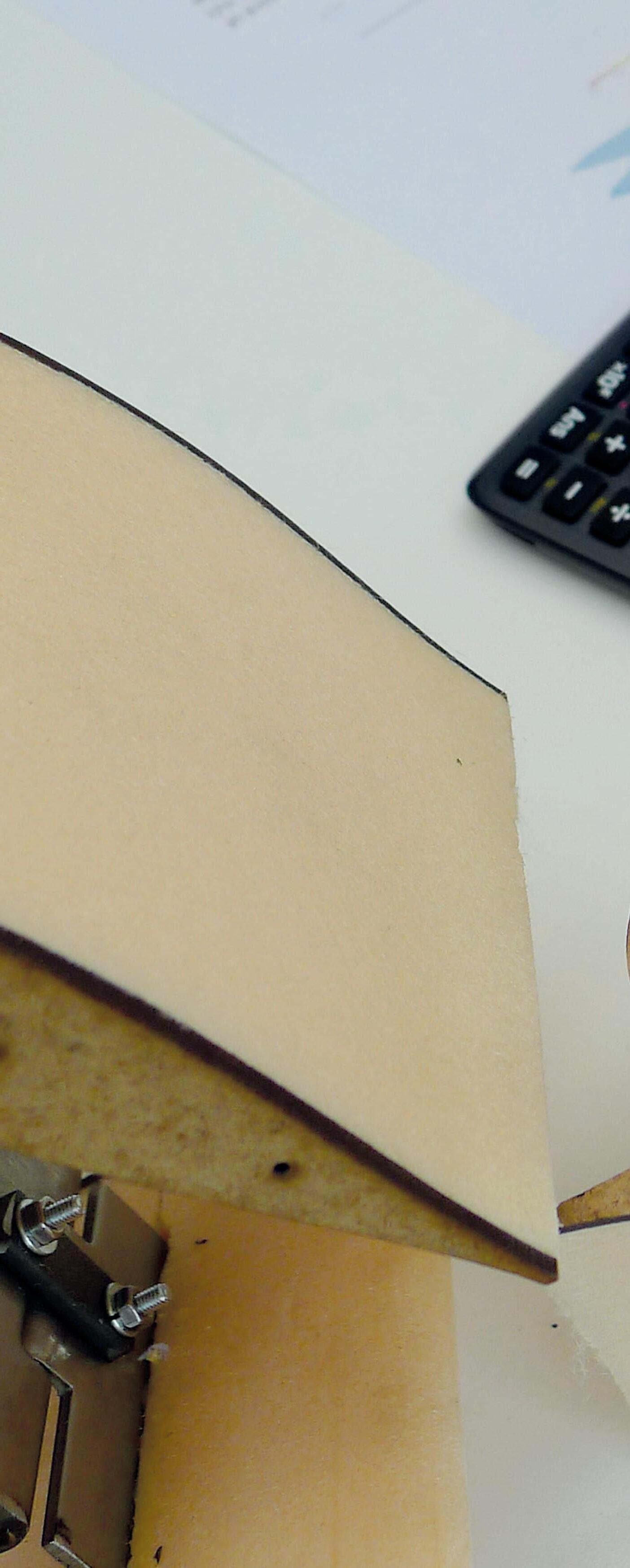
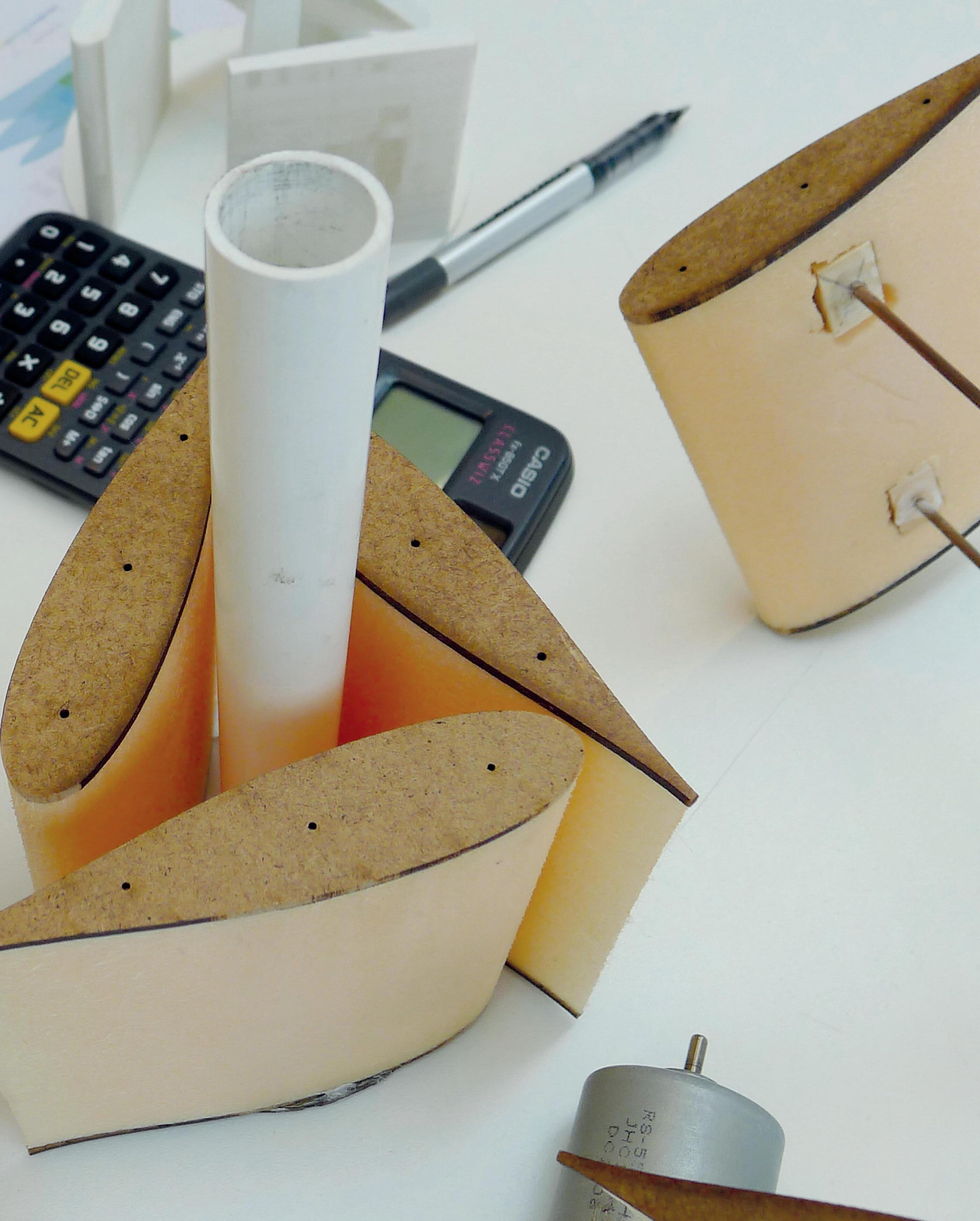
 Craig Whittet Head of
Craig Whittet Head of
The world of Product Development is a global collaboration - being part of a team that works across time zones, fosters innovation, explores insights that ignite discussions, develops and refines ideas and introduces products to market is a dynamic experience. The PDE MSc is an international program that benefits from a diverse cohort and experiences, but the commonality is the aim of developing meaningful interactions that we have yet to experience.
At a local level, the fusion of two internationally recognised and distinctive, educational cultures at the School of Design, Glasgow School of Art, and the James Watt School of Engineering at the University of Glasgow are integral to the PDE experience and the success of the programme. The contents, skills, and methods presented within this publication are the result of an intense year-long educational journey, with subjects ranging from Human Factors to Integrated Engineering Design. Embedded within the students’ PDE experience are projects that focus on how technology can improve life. These diverse projects forge new connections, enhance customer experiences, and promote the opportunity to develop responsible solutions to real-world challenges.
We are always looking to expand our range of external project partners; if you are interested or know someone who would benefit from being involved with PDE, please let me know.
Finally, the PDE team would like to wish the students all the very best. We look forward to more collaboration, exchanging ideas and experiencing the futures that they develop. Please keep in touch!

I believe a good product should serve the user while being simple and effective. Accustomed to an engineering & robotics research mindset, this course has challenged my perspective on design and emphasized the importance of the user in the design stage. Talking to potential product users gives a whole new viewpoint and shapes a product that caters to the need rather than the designer. I have applied this method of collaborative design to my project.
The interest in open-water swimming has skyrocketed since the pandemic as people have understood the benefits it entails. Swimming outdoors helps improve mental health and physical well-being in a fun, adventurous manner. But, in the UK, most waterbodies are cold throughout the year (0 °C – 22 °C), complicating the situation. Although cold water swimming has medical benefits, swimmers face the consequences such as muscle incapacitation and hypothermia and are often uninformed of the time they can spend safely in these waters. Such conditions make swimming dangerous and can lead to drowning.
The product is aimed at these swimmers, acting as a companion in their swims by monitoring their vitals and environmental conditions to warn swimmers when to get out of the water. The product is packaged as an earphone/earplug that monitors core temperature via the eardrum while blocking cold water from entering their ear canals.
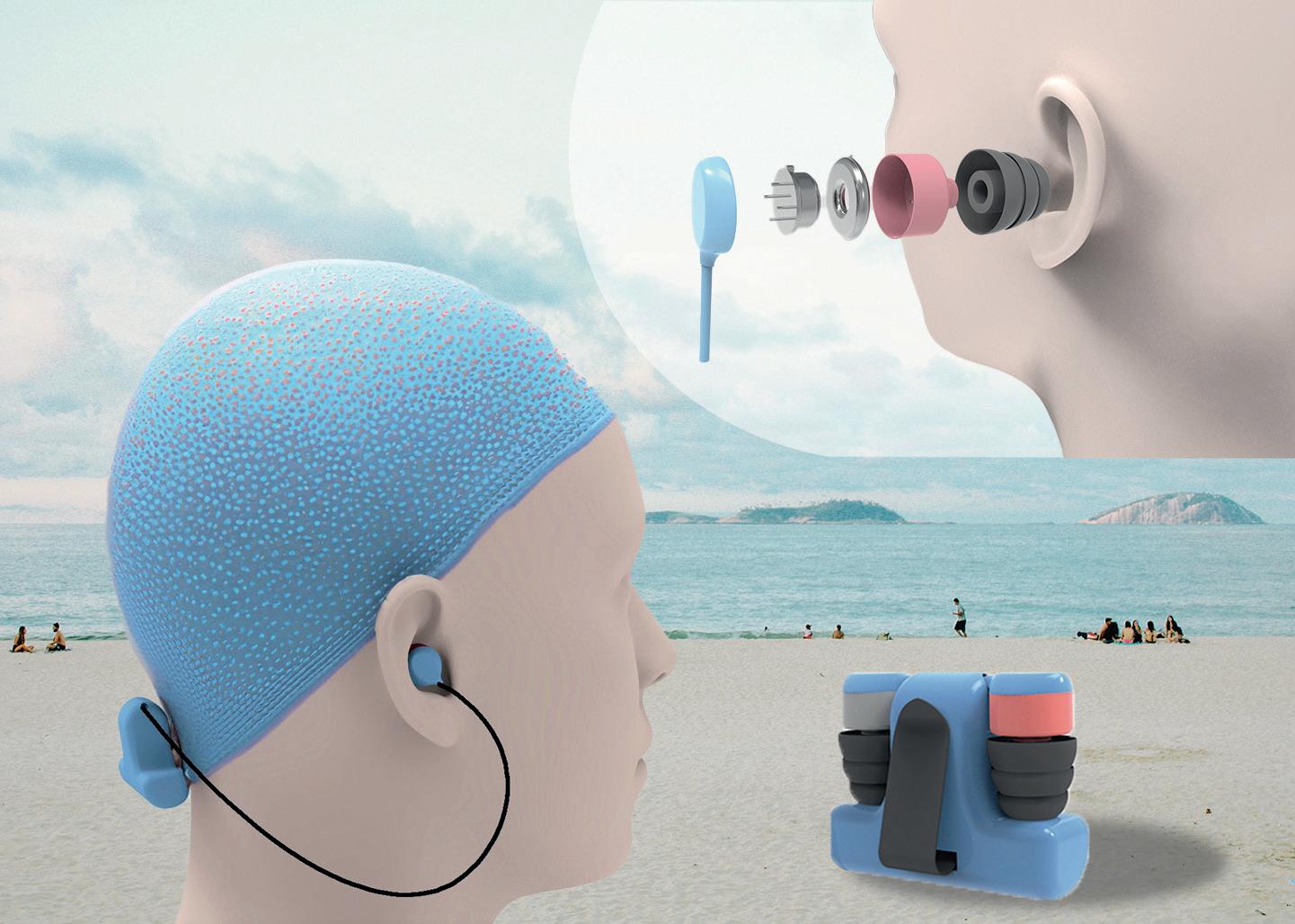
Since I started studying industrial design, what I want to do most is to bring a better life experience to people through my designs. “Designers should be those who can reach into the hearts and minds of people. Understand their emotions and needs.” I have always believed in the importance of emotional stability and happiness. Therefore, in this project, I am committed to helping people find comfort and peace of mind.
My design focuses on individuals suffering from Seasonal Affective Disorder (SAD). I address the direct effects of diminished winter sunlight on mood and the indirect issues SAD can cause, such as a distorted perception of time. I believe that understanding and addressing these often-overlooked aspects can make the treatment more comprehensive and more likely to help sufferers regain their love for life.
I have designed a therapeutic lamp for SAD patients. It helps regulate hormones through light, helping to adjust the person’s biological clock. Simultaneously, by simulating the change in the color of sunlight throughout the day to guide patients in perceiving time, reducing timerelated anxiety. I hope this product can make them feel cared for and supported. During the design process, I emphasized user experience and humanized design, hoping that the lamp meets not only patients’ functional needs but also brings them pleasure through its use.

A Mechanical Engineer with an eye for graphic design, Turned Product Designer. As unconventional as it seems, this path has allowed me to get the better of both worlds – bringing together functionality and Creativity, grounded in the ideas of user-centric design. This course has enabled me to draw inspiration from my previous experiences while simultaneously challenging them - Refining and filtering my method to design and laying the foundation for User-centric Design through a methodical and systematic approach.
Music festivals are increasing in popularity. It has become a means of escaping reality and expressing oneself. However, the surge of crowds attending these musical shows also brings a risk of injuries due to the long hours and physical strain on attendees. Although these festivals are well-organized with sufficient medical staff and well-equipped medical stations, many attendees struggle to find help promptly when they require medical assistance.
To address this issue, I have developed a product aimed at facilitating communication between the medical team and festival attendees. This wearable device allows users to signal the medical team when they require medical attention and enables users to communicate their location to the medical team.
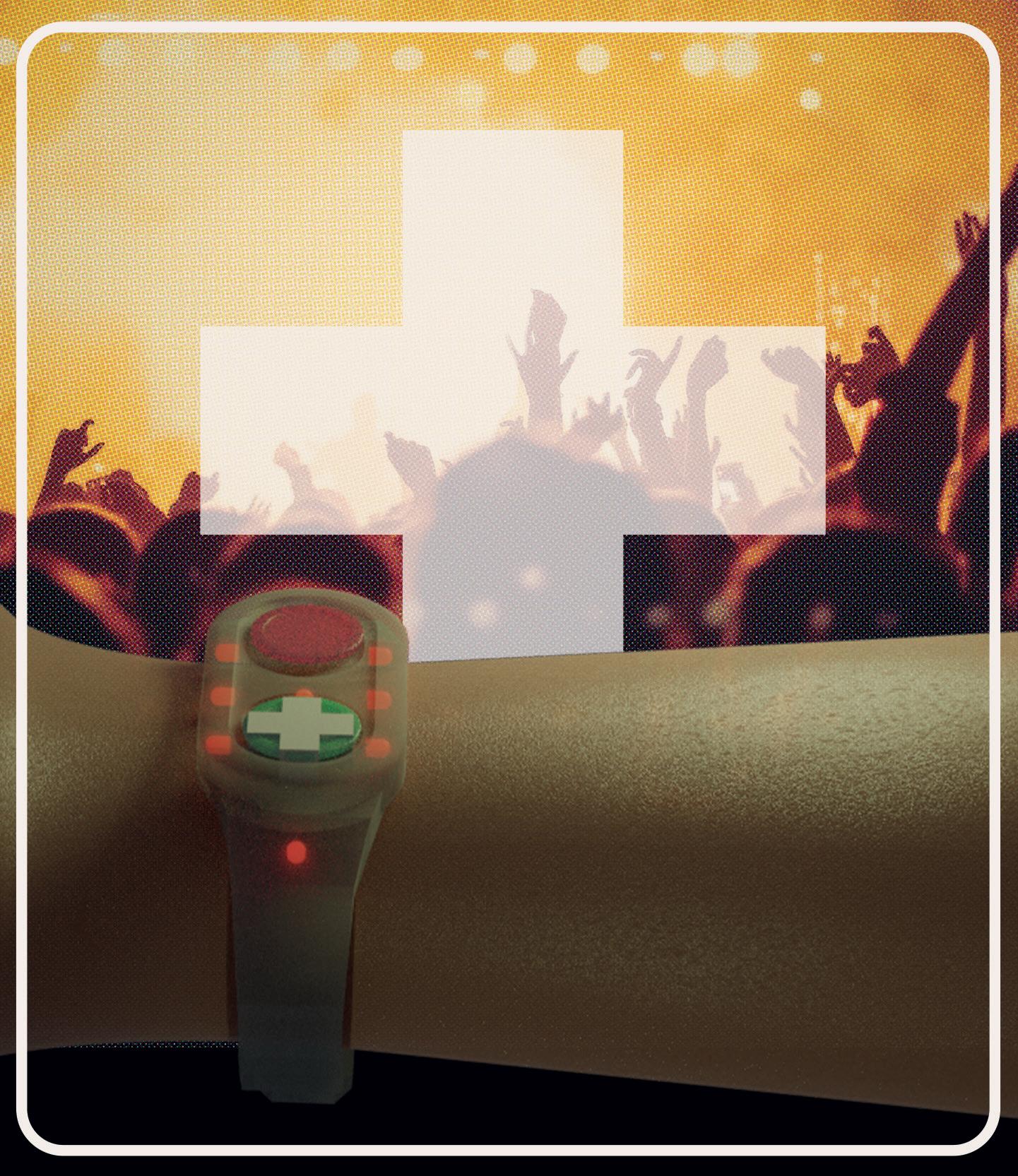
Hi, I am Daniel a product design engineering student at the University of Glasgow and GSA and when I graduate, I want to pursue a career in the renewable design engineering industry. Recently we have seen news reports of wildfires, heatwaves, mass flooding and drought, all of which are consequences of one thing, our planet getting warmer!
Despite the urgent need for action, we are making very little progress in terms of innovation and design of novel solutions that can help with the transition to net zero. Using my knowledge of mechanical and aeronautics engineering, I want to design a product that employs Scotland’s abundant natural resource, the wind, to generate electricity.
Most modern wind turbines are based on designs that have been around for centuries, however what makes my design unique is that I have looked to improve on current design limitations and consider insights from homeowners. My design integrates with a chimney flute to improve the aesthetic impact of micro-turbines, it is foldable when not in use and retractable to help when taking it down from the roof. It will not be able to generate enough electricity to fully power your home, but the considerable percentage that it does generate will make a significant difference to your carbon footprint and help us reach net zero.

I enjoy learning about knowledge in different fields and I love art and drawing, which made me choose to become a product design engineer. 5 years of product design study has helped me to develop my design ability. I love nature, and based on human-centered design thinking, I have become more aware of how people and nature interact, which has led me to focus on human activities in global warming.
Global warming has now become an increasing problem. Global climate change is expected to increase the world’s average temperature by about 2-4°C in this century, which means that hot weather will become increasingly frequent. Higher temperatures will increase the possibility of heat stress, and seriously affect human health. This effect is greater for outdoor workers in areas with hot temperatures during the summer months, as it is difficult for them to receive effective cooling during or after work.
My design is a wearable product that can help workers to cool down to prevent potential heat stress problems. The main function of this product is air cooling to accelerate the evaporation of sweat, while also monitoring the user’s temperature and providing an early warning when the person’s body temperature and the surrounding temperature are too high.
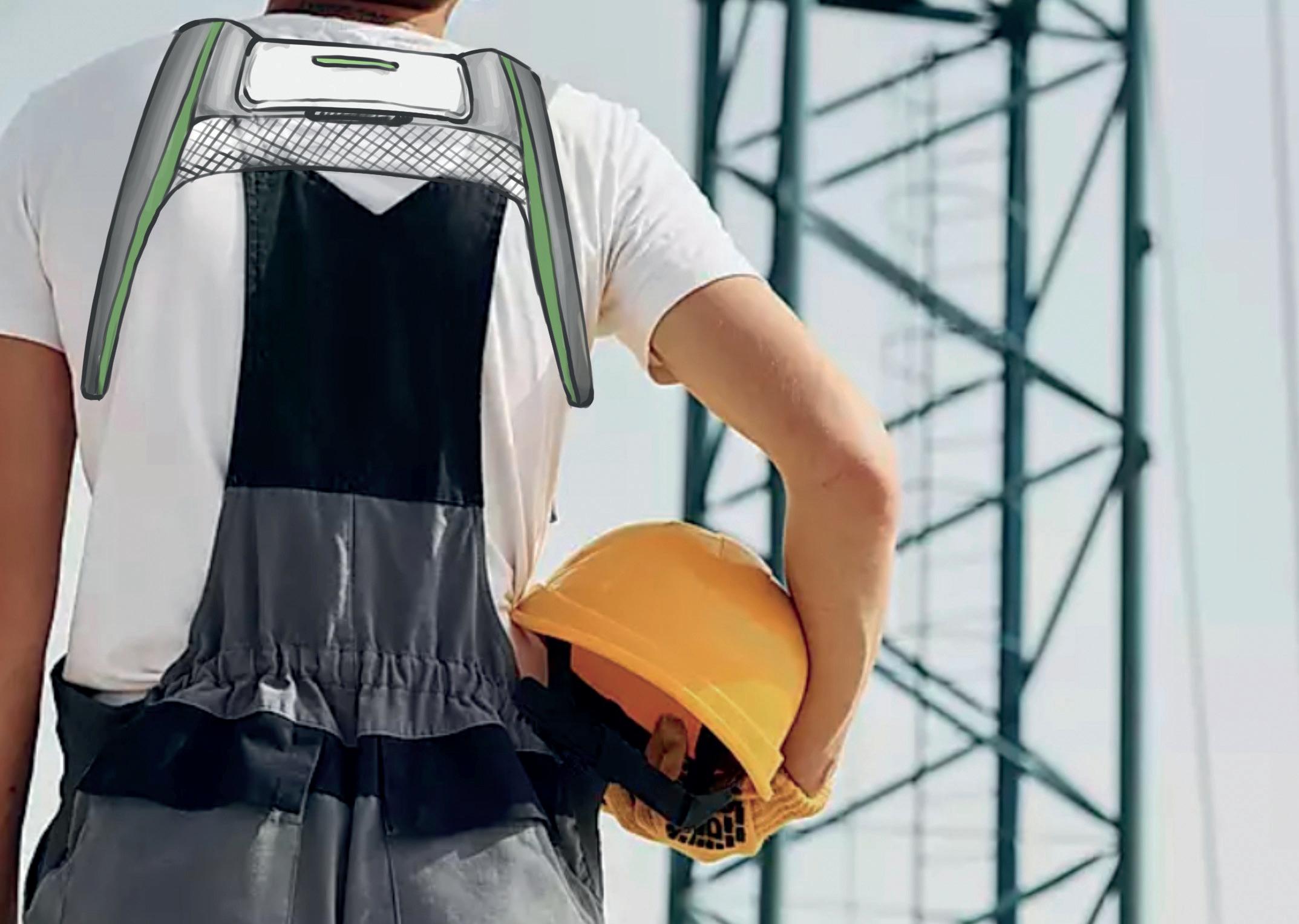

As a Product Design Engineer with a solid foundation in Mechanical Design Engineering, my practice involves the ideation, design, and development of practical solutions from concept to production. I possess a keen interest in the principles of circularity, sustainability and innovation and incorporate them into my work when possible. I am passionate about using my skills to genuinely improve lives by solving societal, environmental and sustainability problems.
My major project is a solution to the 250,000 abandoned tents at music festivals each year. By delving into the mindset of those who abandon tents and by questioning music festival organisers, I have gained insights into the philosophies and motivations of both parties. By analysing these insights and through the application and testing of innovative size expanding mechanisms, I developed a housing structure specifically designed for rental services. Including a quick pitch mechanism, allowing users to easily pitch and pack the structure, maximising efficiency, and user convenience. The structure is composed of an exo-frame that provides robust and weatherproof support and many more features that help produce a streamlined and enjoyable user experience.
Overall, my project looks to promote and provide realistic and approachable solutions to the growing issue of resource wastefulness and aims to inspire circularity in people lives.
My design practice represents a fusion of elements from my previous studies and interests. I drew upon both my undergraduate studies in physics, as well as my interests in fashion and textiles. My training in both scientific reasoning and design thinking through my studies and independent travels has inspired much of my work so far, with observations and understanding intertwined in every design decision.
My major project is rooted in my love of making clothes and explores the damaging disposal nature of today’s fashion industry, focusing on textile waste specifically. Textile waste is an issue we all add to, so through this project I have designed a product to assist the everyday consumer of fashion in mending their clothing. Fixing our clothing and extending a garment’s lifetime not only decreases the amount of clothing thrown away, but also the amount of clothing bought.

Visible mending is a choice to make something new and call attention to the imperfections, whereas invisible mending is the decision to keep your clothing the same and continue to enjoy the garment as you always have. Newer technology including AI and digital fabric printing are used alongside traditional reweaving processes in this project to create and attach a seemingly camouflaged patch over damaged clothing.
Growing up in a multicultural environment, I was stimulated by diverse points of view and problem-solving approaches to universal challenges, which drove me to explore the discipline of product design. Through my educational path with a focus on science and engineering, opportunities to ideate unique designs where I can demonstrate my creativity and experiences excited me. What motivates me to design is to make people enjoy the present moment, detached from the stresses of daily life. I am, therefore, passionate about designing entertaining experiences for all ages.
What I like about the design process is the constant exploration through observation, expansive use of imagination, and approaching everything with curiosity. Thus, I was inspired by the most curious minds—children— and how they discover to make sense of the world. In my major project, I concentrated on designing for play and learning, which I believe is the best when intertwined.
I designed ‘smart blocks’ that would guide children through their quest for grasping abstract geometrical concepts. This fun and interactive toy shall develop their spatial skills, by making them practice building a 3D dimensional construction from a 2D reference. I call it conventional building blocks, reinforced with technology.
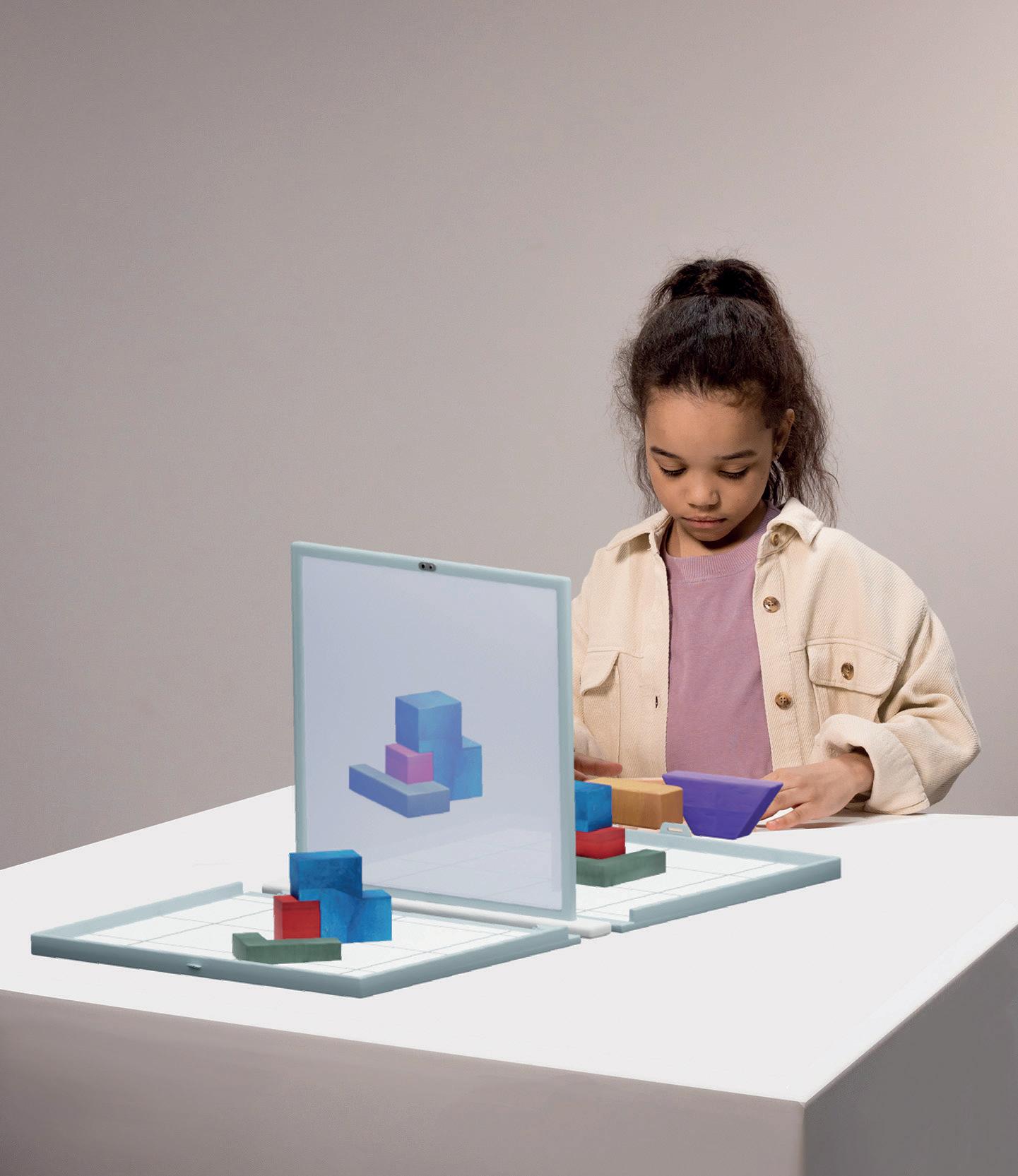
Hi, I’m Ningxin Tang from China. I majored in industrial design as an undergraduate before deciding to pursue a degree in product design engineering because I have a passion for beautiful and creative things. I aspire to be a perceptive designer who appreciates life and sees the challenges, joys, and beauty all around her. In order to create a warm design, I seek to strike a balance between art, science, and humanistic concern.
Starting with the little things and experiences of life, I want to bring convenience and happiness to every individual. My initiative to recycle coffee cups begins with environmental concerns and aims to employ thoughtful process planning and coffee cup design to enhance consumers’ on-the-go coffee-drinking experiences more interesting and environmentally beneficial.
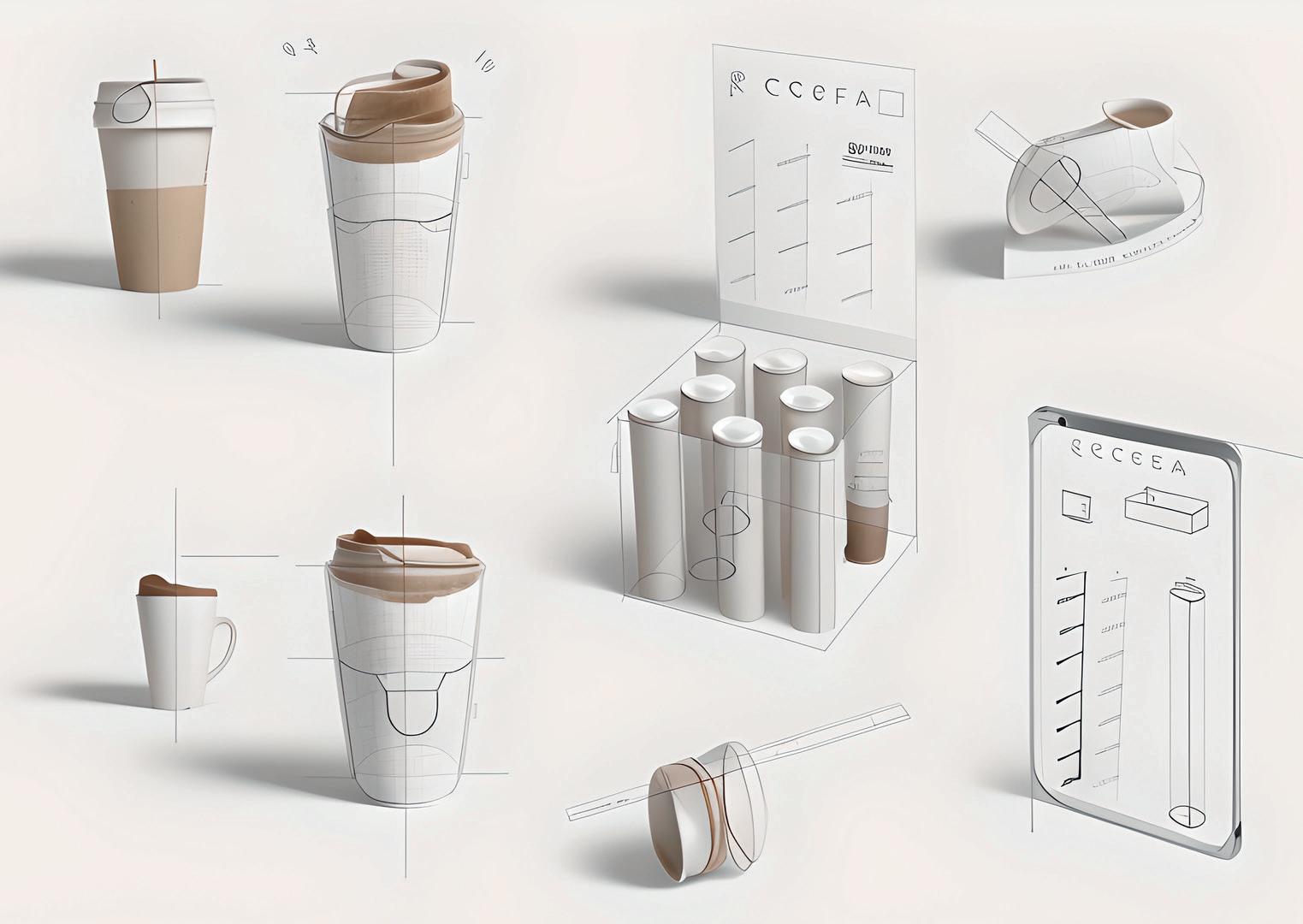
These days, a lot of coffee is taken in throwaway cups, and carrying around reusable cups is not that common, yet. Therefore, a reusable cup that can be used again right in shopping malls with lots of coffee shops is a helpful solution. It is simple to carry and clean without significantly altering how people use products.
Four years ago, I decided to give up my studies in Fine Art to study Product Design. Fine Art opened my eyes to many different ideas, but in the process, I realised that I preferred to design products that could help others. I started to observe the little things in life, always following the human-centred design philosophy and focusing on the relationship between humans and nature.
Increasingly biodegradable plastics are now appearing on the market. Among them, home-compostable plastics have gained a lot of attention because of their ability to be composted at home. In fact, for various reasons such as incomplete knowledge of the labelling of the different types of plastics and the fact that the home environment is different to the laboratory environment, composting of more than 60% of ‘homecompostable plastic’ fails. This has greatly discouraged people from composting with home-compostable plastics.
My design aims for people to use home-compostable plastic as a common compostable material used when composting at home. The compost bin I have designed controls the temperature, humidity, and oxygen content of the compost bin by monitoring the conditions set according to the degradation conditions of the home-compostable plastic, enabling the compost pile containing the home-compostable plastic to be composted and put to use within three months.

Being someone who has always been curious, I studied for a Bachelor’s in Mechatronics Engineering to get a better idea of how things worked and operated. Followed by the MSc in Product Design Engineering, I have furthered my understanding of human-centric design. Building things has always been my passion, and I love exploring the latest mechanisms and technologies so that I can use these in my own ways within the products I develop. Having worked in the field of medical devices and automation, I have gained knowledge and understanding when it comes to design for safety and design for manufacturing.
Anyone who has worked on a DIY build project knows how messy and cluttered a workbench becomes with tools and instruments. Around half of these are usually measurement tools. Since there is a separate tool for each type of measurement, it is not easy to carry them around and some tools are always missing. Most of these tools are still manually operated with limited resolution and flexibility.
To solve this issue, I have developed a working digital multi-measurement tool which can work as a spirit level, laser level, angle finder, measuring tape, laser distance measure, and roll measure. The device comes with one ruled edge, wireless charging and a torsion hinge which also works as a stand for laser-level setup.

My inquisitive nature made me wonder how things work and why they are the way they are. Through my education in Mechanical Engineering and Product Design Engineering, I learned much of what goes into the making of a product from technology considered, to user-centric design. In my view a superior product is delivered by ensuring intuitive user experience, solving real life problems and creating products that enhance people’s lives.
In hotter climates people cool themselves for personal wellbeing with various devices and techniques, but in situations with high heat and humidity there are few options other than using air conditioners. AC’s come at a cost of high energy consumption and expenses making it unviable for many. With forecasts of 5 billion AC’s units in use by 2050, imagine how much energy could be saved if there were a more efficient alternative.
AC’s are made to cool the entire space and not just the person in it. This led me explore the possibility of an alternative that provides localized cooling for users, which can save energy and reduce various effects caused by AC’s. Based on usage pattern and requirements, I focused on scenarios where consumers needed cooling the most at home, creating a micro-environment by enclosing the bed with a canopy like structure which is cooled.
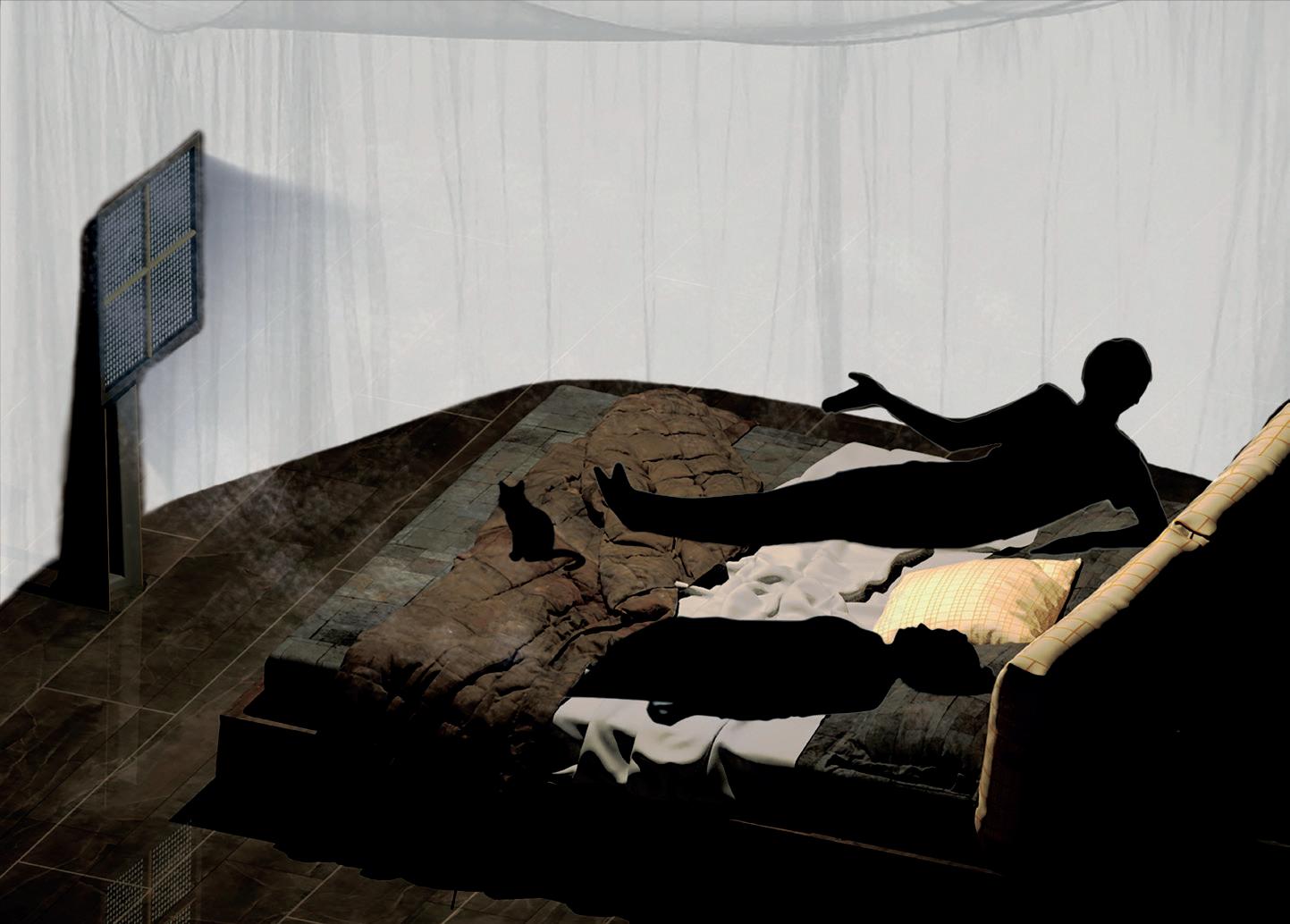
As an individual deeply rooted in the belief that “movement is medicine,” I am passionate about the transformative power of an active lifestyle. For me, the outdoors serve as both a playground and a sanctuary, where I can fully embrace my love for being active and immerse myself in the wonders of nature. This zeal for movement and the natural world has been the driving force behind my latest project, HAPTA.
HAPTA is a smart haptic brace that I have been developing with a vision to revolutionize post-surgery physiotherapy. With a firm conviction that the road to recovery lies in movement and exercise, HAPTA is designed to assist individuals in moving correctly and effectively in the long term. By providing real-time haptic feedback, it guides users through their rehabilitation process, ensuring they achieve their full range of motion and regain strength with every step they take.

In essence, I am a firm advocate of living life to the fullest through movement and adventure, and my project, HAPTA, embodies this very philosophy. As I continue to give my best into this endeavor, my ultimate goal is to empower individuals to embrace an active lifestyle, heal through movement, and rediscover the joy of a life in motion.
I discovered Product Design as a major when I was in the second year of undergraduate and have been into it ever since. It’s the incredible creativity and imagination that attracts me all the time. Now I have been in this major for over 5 years and I still remember and enjoy the feeling of starting a new project as well as designing a new product. I do believe that as a product designer we need to design a product that could bring happiness and convenience to the users, which has been a passion for me and supports me to design all the time.
This time, I want to design something that feels delicate and tender. Combined with my personal experience, I decided to try to design a product related to sleeping postures to help people improve the quality of their sleep and to reduce the pain and soreness they have while sleeping in a bad posture. I plan to realise my design using components including micro-controller, inflatable airbags etc. The functions based on the elements above would include automatic adjustment, monitor, and feedback, which makes the product human-centred and user-friendly. Limited by current conditions, the final product might not be perfect, but I would try my best to use the prototype to do the simulation.

Reading about the works of Leonardo Da Vinci made me realise that there is a unity between creativity and critical thinking, and that, for me, is design. As a product designer, my products are created from a place of thoughtfulness, respect, and passion; if there is a problem that I am passionate about, I will design a solution for it. Leveraging my electrical engineering background with my sheer interest in product design and music, my major project focuses on how to empower and engage communities with similar interests - people who share the love of playing fretted instruments such as a guitar or ukulele.
A survey conducted by Fender revealed that approx. 90% of beginners give up playing within the first few months. Anyone who has tried learning guitars would know that the prominent reasons are difficulty remembering and learning chords, absence of access to guitar tutors and lack of personalised feedback. Hence, in enhancing this pedagogical experience, I optimised the ease and efficacy for individuals by visual learning of chords and building muscle memory through correct finger positioning and visual feedback.
The idea is to have a detachable device that fixes onto your instrument and enables you to play it as you go without much prior knowledge. Furthermore, this can also be integrated with an app for ease of use.
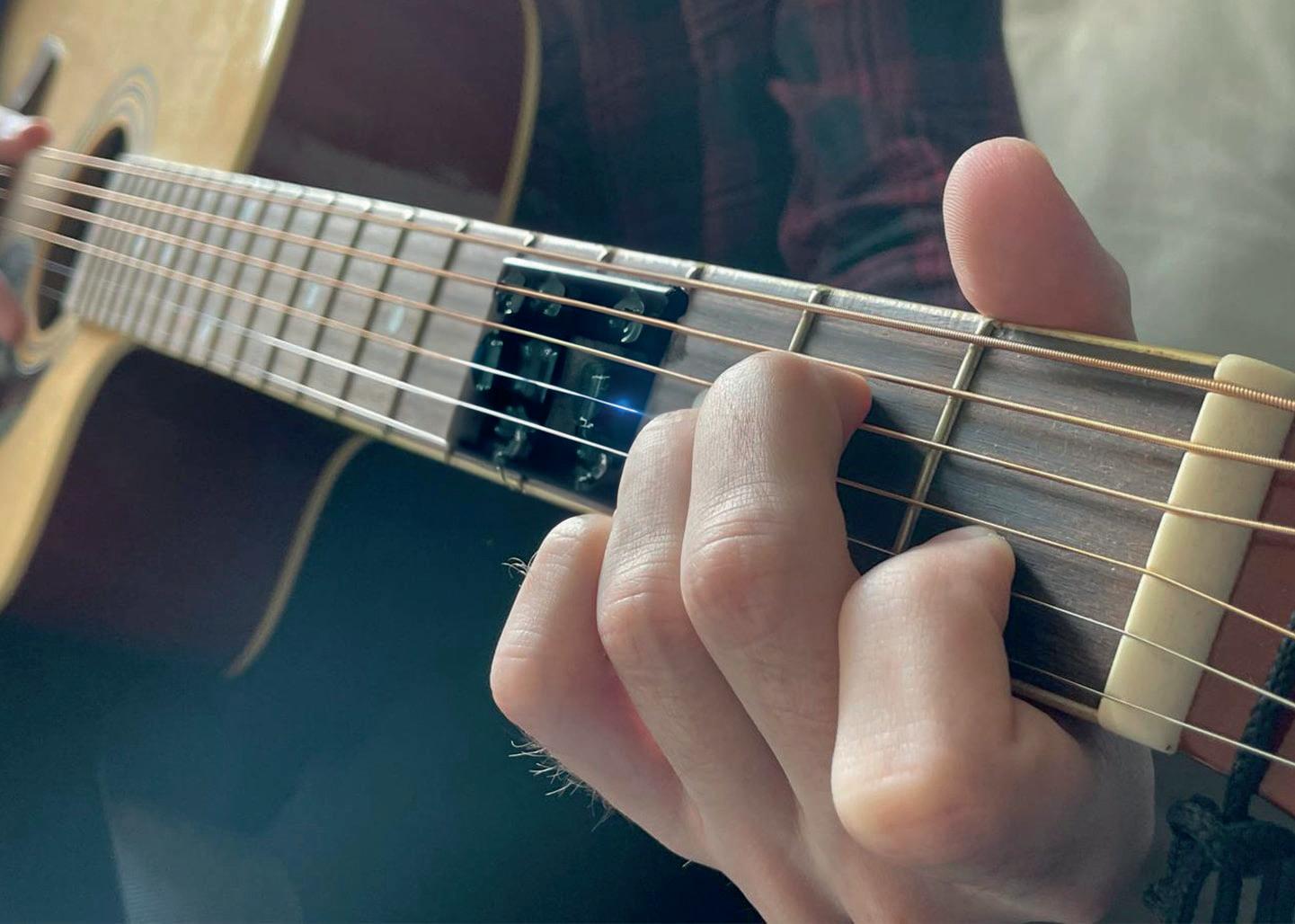
Design is not just an art; it also offers solutions to problems. Through the combination of engineering and design, functional and practical solutions can be created to address real-life issues. Effective communication between the product and the user is equally important, ensuring that users can easily understand how to use the product at first sight.
My work focuses on ankle foot orthotics, controlled ankle motion CAM) walking boots, and alternative plaster casts. These devices keep the foot and ankle in a relatively neutral position during ambulation, supplying excellent support and evenly distributing the load over a larger area. By consulting orthopaedists and walking boot users, I have found certain issues that need to be resolved.
To tackle these challenges, I have adopted a combination of Generative Design (Fusion 360), Finite Element Analysis (FEA), and 3D printing technology. By using these tools along with human factors considerations, I have developed a final boot design that can be customized to fit individual feet. The result is a lighter, better-ventilated, easy-to-clean, and quickdrying product that reduces manufacturing time and minimizes the risk of secondary pain. Additionally, the improved recyclability of the boot promotes sustainability compared to current walker boots.
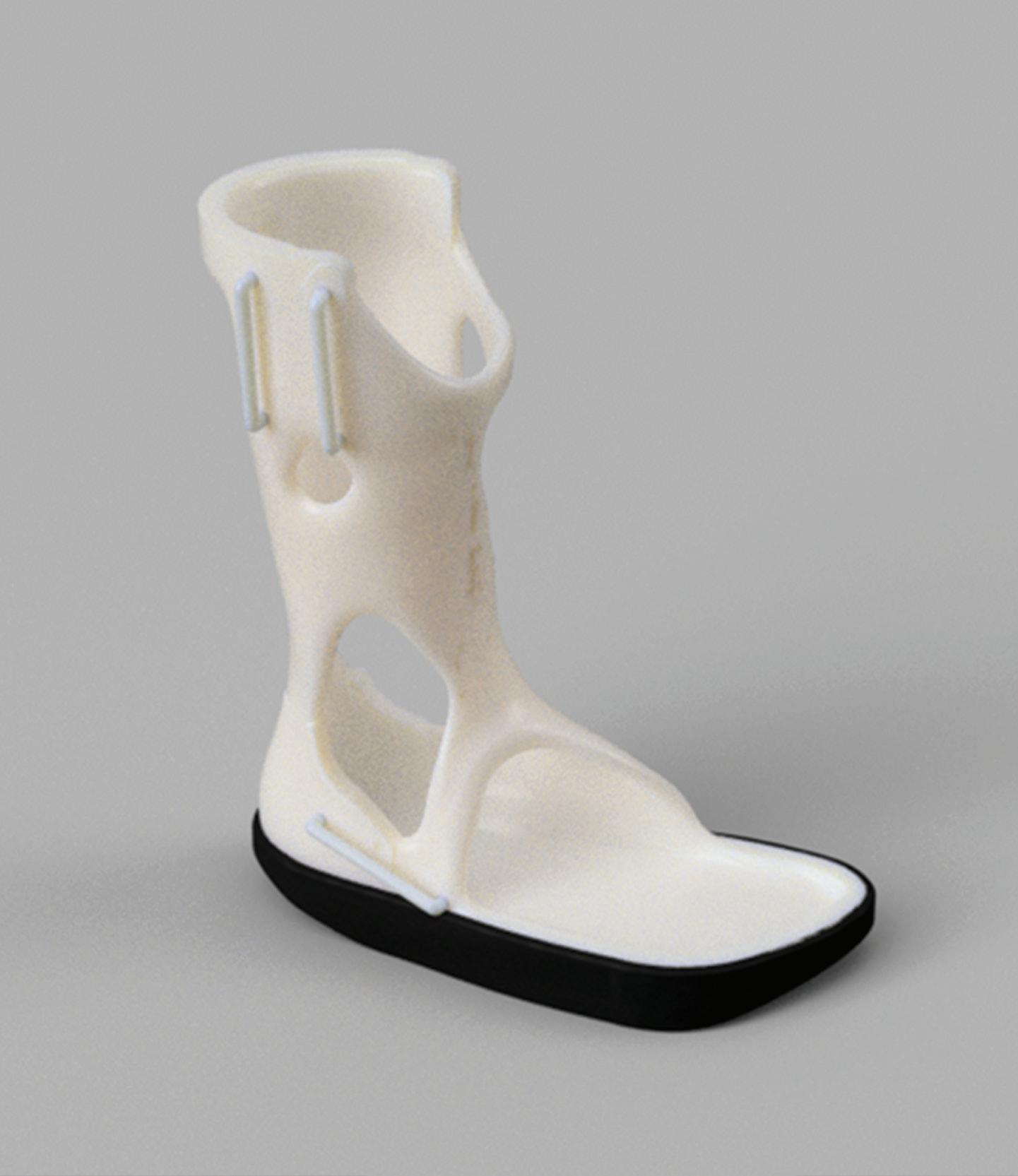
I am the type of person who is curious about knowledge in various areas. I majored in physics as an undergraduate, but I generated an interest in product design when I saw that some design works could be designed that way. Creative and innovative designs fascinate me, which requires me to keep observing social issues and to keep learning cutting-edge technology and knowledge. I want to enter this industry after the PDE programme.
Now is the stage where I practise what I have been learning. In my major project, I am focusing on the health issues faced by wheelchair users. The research shows that up to 80% of wheelchair users have undergone shoulder impingement due to overuse of the shoulder. Medical advice suggests doing exercises to avoid stiffness and strengthen shoulder muscles. However, it is difficult for wheelchair users to use the equipment in gym as the current market rarely considers specific requirements and constraints for wheelchair users.
My design is to develop indoor fitness equipment which is suitable and easily used by wheelchair users. This equipment allows wheelchair users to exercise shoulder muscles. The design process places an emphasis on human factors and ergonomics. My motivation for this project stems from the lack of attention and available solutions in the market for disabled people.
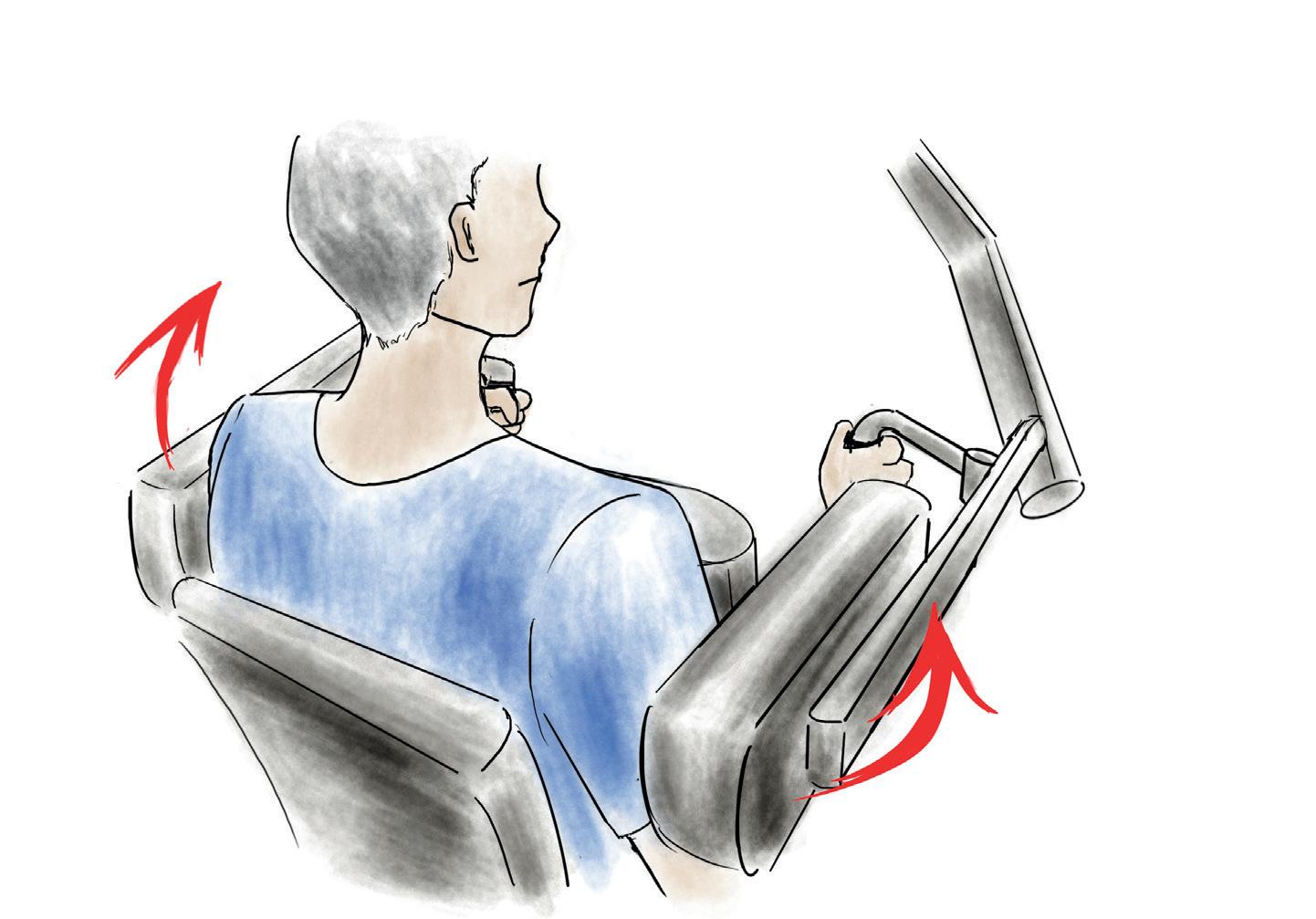
As a car and motorcycle enthusiast, it has always been my dream career to be involved in the design of vehicle-related products. During my Bachelor’s studies, I learnt a lot about structural engineering and vehicle-related technologies, but this was not enough to fully design a product, so I used the PDE project to better understand how to design my ideal vehicle and its peripherals with a user-centred approach.
My main project is based on my real-life experience. Over the years, I have been experiencing spills during the delivery of my takeaway orders, and from my experience of riding a bike/motorcycle, I believe that these spills have a lot to do with the rider’s body dynamics during the delivery of food. Therefore, my main project is to change the design of the backpack to reduce the impact of the rider’s body dynamics on the stability of the food in the backpack.
Throughout the design process, my main concern was to strike a balance between maintaining food stability and reducing the weight, and I researched a lot of tech-wear designs during the development. I believe that my final design will improve the stability of the food in the backpack compared to existing ones, while reducing the use of electronic devices as much as possible and keeping it lightweight.
↘ LinkedIn /xinyi-wang-457938160

My passion for industrial and product design has only grown stronger since I embarked on this journey as an undergraduate. Today, I find myself deeply immersed in the field, constantly exploring new avenues of research. My fascination with design stemmed from a desire to manifest my inner thoughts into tangible creations. This led me to undertake numerous product design projects, where I embraced the iterative process of blending creativity and technology to address human-centered needs. And the gratifying experience of solving real-life problems through innovative and technology-driven solutions has been immensely fulfilling.
Currently, I am working on a significant project as part of my postgraduate studies. My focus is on developing a cutting-edge, human-centered medical rehabilitation product. The primary objective is to integrate innovation and technology seamlessly, offering a modular approach to rehabilitation and treatment. This design empowers patients to engage in rehab exercises at their convenience, guided by light emitted from the rehab module, even during various times of the day. Additionally, a recovery module equipped with near-infrared light provides pain relief and facilitates the healing process. Notably, the modular design allows patients to wear only the recovery module on rest days. The wrist strap, designed to accommodate personal preferences, ensures a comfortable experience. Moreover, the project includes an assistive tool to enhance the rehabilitation process for patients.
My name is Yi Xiao. My academic background bridges the technical rigor of mechanical engineering with the innovative spirit of product design engineering. As an undergraduate, I honed my analytical skills, delving into complex calculations and understanding the intricate physics that underpin our world. However, I soon realized that my ambition transcended the realm of pure calculation and ventured into the creative sphere.
I chose to specialise in Product Design Engineering for my graduate studies as I see this field as the perfect intersection of creativity and technology. It allows me to bring forth solutions that are not just functional, but also human-centric and aesthetically pleasing. My aim is to develop products that add value to people’s lives, addressing real-world issues with an engineer’s precision and a designer’s eye.
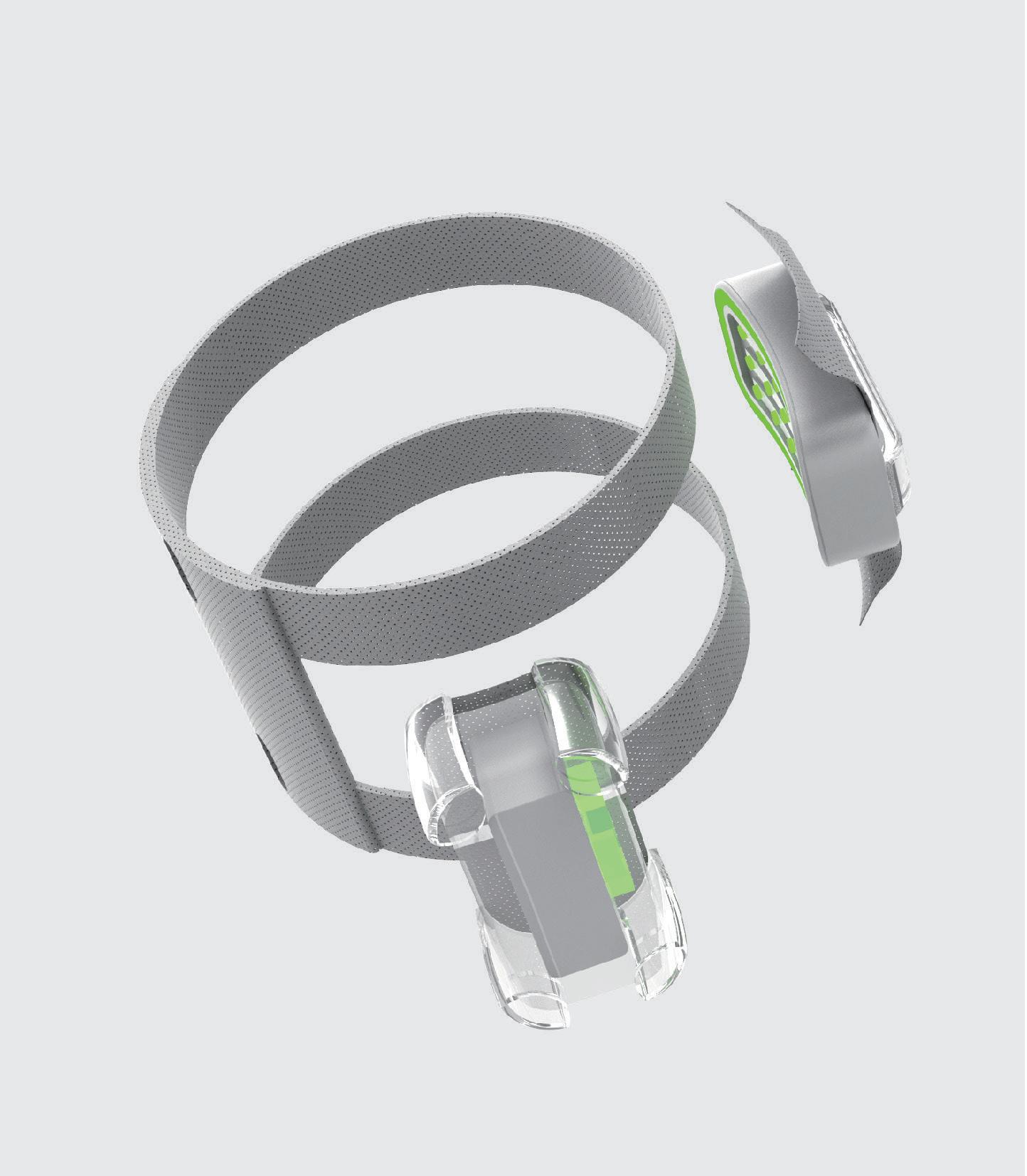
My major project, the Autonomous Mountain Safety Station (AMSS), is conceived for the rugged terrains of the Scottish Highlands. The AMSS is a compact, portable, and autonomous station designed to enhance hiker safety. It combines the principles of mechanical engineering, product design, and user experience, embodying my passion for leveraging technology to better the world around us. The AMSS represents not only the Learning outcomes of my academic journey so far but also a glimpse into the bright future of interdisciplinary innovation that I aim to be a part of.

I am a product designer with a background in industrial design. I have experience in developing medical devices, particularly in exterior design, including endoscope systems, oxygen machines, and vital sign monitoring devices.
Having a passion for outdoor activities, I have chosen to work on a project related to outdoor toileting. Traditionally, we have been taught to dig cat holes for outdoor toileting to promote environmental preservation. However, recent research has shown that cat hole burial may not effectively decompose waste, especially in challenging geographic environments like the Scottish Highlands, where there might be limited microbial and soil conditions to aid decomposition. Therefore, it is more practical to pack and carry waste out.
The product is designed to securely attach the waste bag to the user’s hip, allowing for easy access during outdoor activities. The storage bag is designed to be foldable, enabling users to store multiple waste bags in a compact manner. The sealing mechanism incorporates a triple-fold closure along with a zipper, ensuring a tight seal for odor containment and facilitating multiple uses. By addressing the challenges of outdoor toileting in adverse weather conditions and rugged terrains, this innovative design aims to provide a reliable and user-friendly solution for nature enthusiasts, promoting environmental sustainability through responsible waste management.
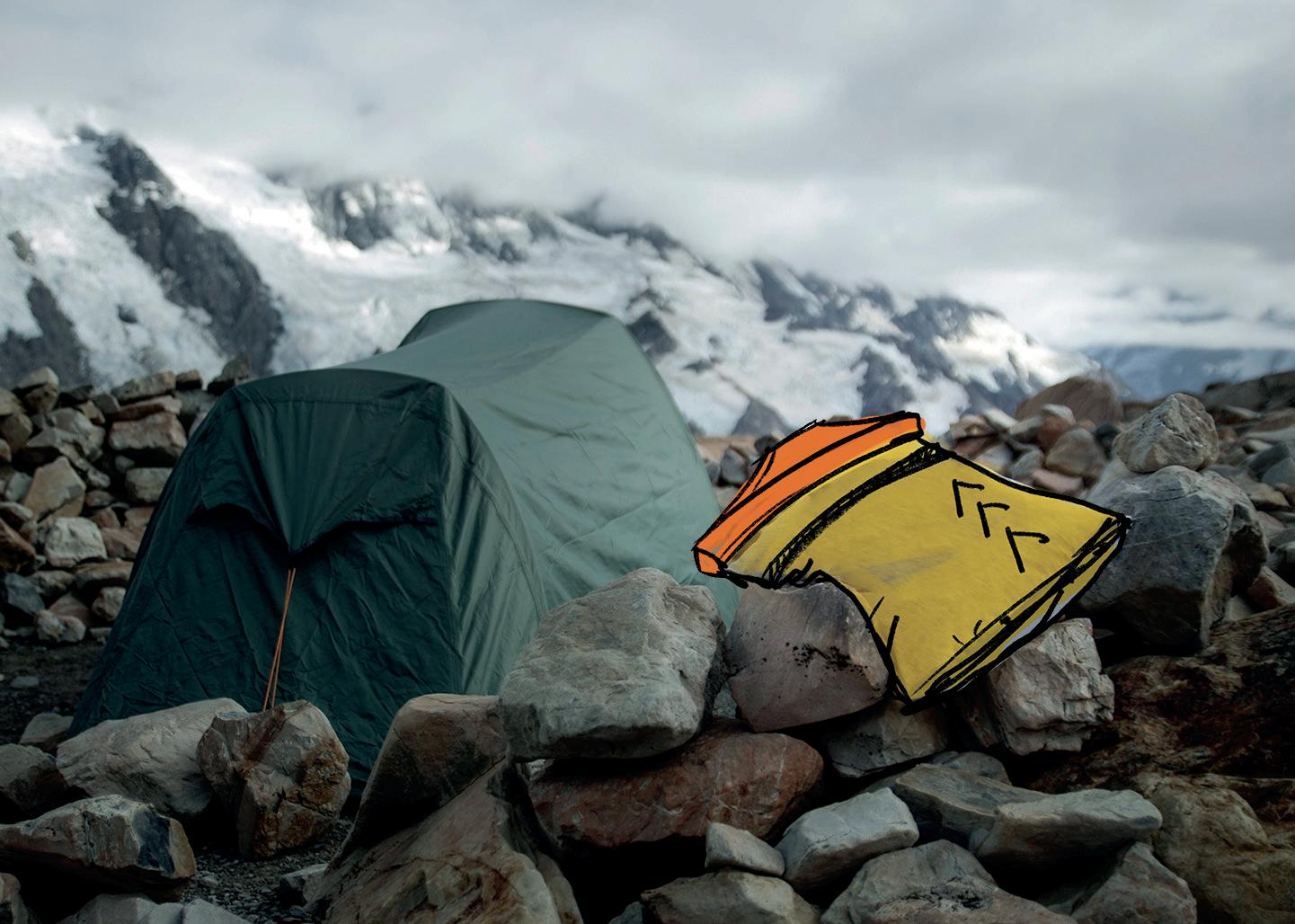
My curiosity about the working principle of things and the hobby of DIY made me choose to be a product design engineer. I have studied a combination of product design and engineering for five years. In my opinion, an excellent product design is user-centered and highly achievable. I hope my design is rigorous and logical, so in the design process I am used to supporting my design development with data and experiments.
In recent years, news of sudden death of young people has been frequently reported, which made me pay attention to sudden cardiac death and first aid methods. The fatality rate of sudden cardiac death is as high as 80%. This is because the survival rate is closely related to time. Every minute defibrillation is delayed, the survival rate will decrease by 10%. According to the survey, 80% of the victims had CPR administered before the ambulance services arrived, but only 8% received defibrillation. What hinders the use of public defibrillators?
My development focus is to reduce barriers to the use of defibrillators by the public. By broadcasting and alerting, passersby can identify defibrillators and transport them to the location of the cardiac arrest to support the first responders and shorten the time required for defibrillation.

As a curious and sensitive individual, I often view the world with a sense of inquisitiveness, and I am drawn to intriguing and novel details. This inclination helps me empathize with the perspectives of designers and the experiences of users. As a student of product design, I pay special attention to the finer aspects of user experience, including humancomputer interaction, material selection, and aesthetic expression, all of which reflect my concern for the users. The ultimate measure of a successful product is defined by the market demands revealed through user experiences.
During my first year in Glasgow, I noticed a scarcity of motorcycle riders here. Through a comprehensive analysis that combined environmental and cultural factors, I identified environment and safety as crucial considerations. In Glasgow (UK), the climate frequently leads to rainy days, posing a significant challenge for motorcycle riders. Rainwater accumulating on helmets during wet weather affects the riders’ perception and understanding of road conditions, thereby jeopardizing their safety. While riding at high speeds may help disperse raindrops, it inevitably creates more safety hazards. Therefore, if we can ensure relatively safe riding speeds and employ an aerodynamic structure on the helmet to accelerate the airflow, we can assist in blowing away raindrops, thus alleviating the issue of obscured vision caused by raindrops on the helmet visor.
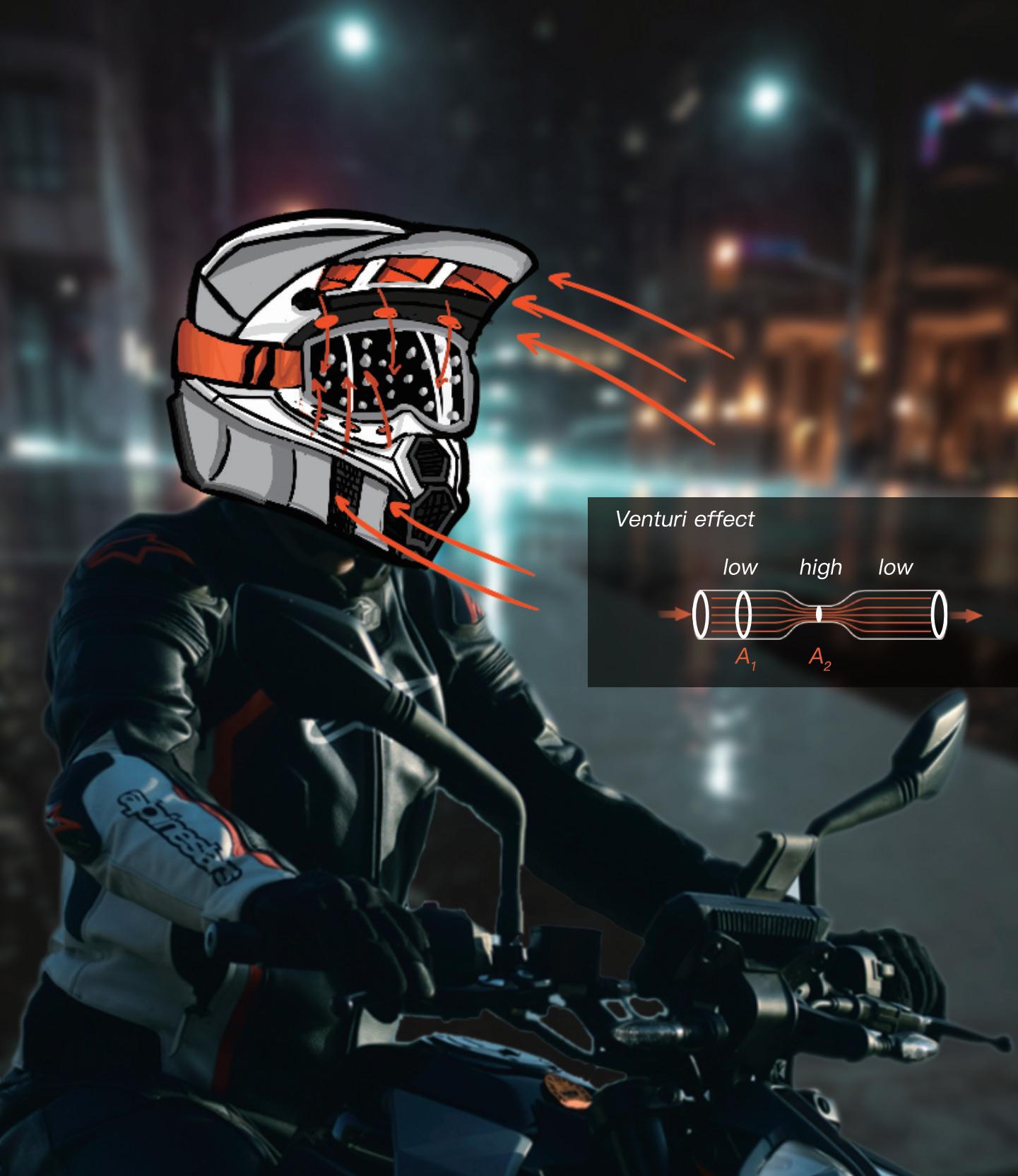
I am a product designer with a background in industrial design. Currently, my research and project experience mainly focus on consumer electronics products. I am skilled at using user-centered design methods to understand user needs and generate creative product ideas. However, my knowledge of engineering structures is somewhat weak due to my undergraduate emphasis on design methods and industrial design aesthetics. During this year’s course, I had the opportunity to apply crossdisciplinary knowledge gained from project practices, including materials, programming, manufacturing, ergonomics, and more, to understand how to design products from an engineer’s perspective. I believe this will positively impact my future product design career.
My graduation project is a Circadian Rhythm Lamp using light therapy and ergonomic principles. It offers intelligent as well as interactive illumination before bedtime and in the morning to help adjust biological clocks affected by night-time indoor light pollution and Delayed Sleep Phase Syndrome (DSPS). Users can activate a night light with a countdown timer by rotating the product 180 degrees. The light fades gradually as time passes until users fall asleep, and to turn the light on again, users need to rotate it several more times, increasing the difficulty for those who stay up late. In the morning, a natural light alarm will automatically turn on, facilitating the adjustment of their biological clock.
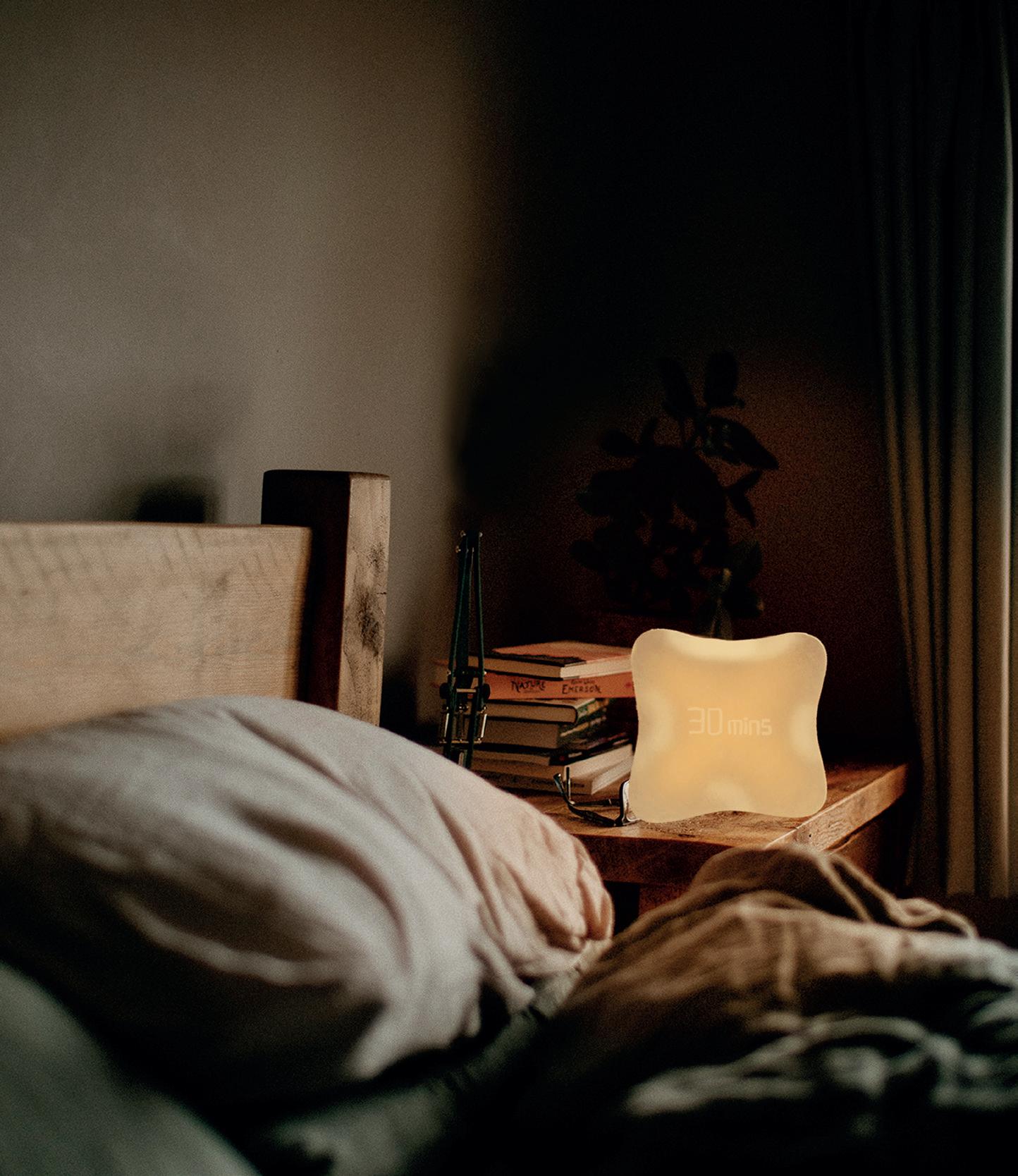
As a product designer who studied physics during my undergraduate years, my design practice focuses on solving real-life problems with creative and logical thinking based on theory. I leverage the broad scientific knowledge I possess to transform innovative ideas into reality through engineering solutions. Additionally, my experience in the car industry has taught me how to approach product experiences as a series of small design challenges, much like assembling a car with hundreds of components.
My design inspiration mostly comes from discoveries and reflections on life experiences. My major project originated from an experience during travel when damp clothes emitted unpleasant odours. This incident sparked my interest in designing clothes drying aids. Interviewing potential users has further inspired my design goal to provide effective drying solutions for various contexts, regardless of whether it is sunny or cloudy, whether people live in spacious mansions or small apartments, and whether they have heavy winter garments or everyday clothes. Ensuring the well-being of the owners and the healthiness of their clothes is the core objective of my design.

Everyone’s energy is limited. Therefore, my design objective is to bring joy to people through my product and liberate them from mundane tasks, allowing them to channel their limited energy into things that truly matter to them.
Five years ago, I decided to change my major and move from fashion design to product design. At that moment, I knew that in terms of design, having an aesthetic foundation was far from enough. I have always believed that design is for solving problems, and I try to cultivate my ability to discover problems in life and view problems with the mindset of a designer.
For my major project, my starting point is a problem that happens every moment in life. Domestic food waste is a small issue but has a significant impact. I summarized the causes of the problem and decided to start with the storage method to reduce the possibility of Food Waste. My project focuses on people living alone as they often experience the challenge of finding appropriately sized portions available in supermarkets and often cannot consume the quantity of food purchased before it goes off.
So, my solution is to help them arrange food more reasonably and extend the shelf life of the food through packaging materials. User testing is an important part, so I tried multiple model manufacturing and invited different people to use it.
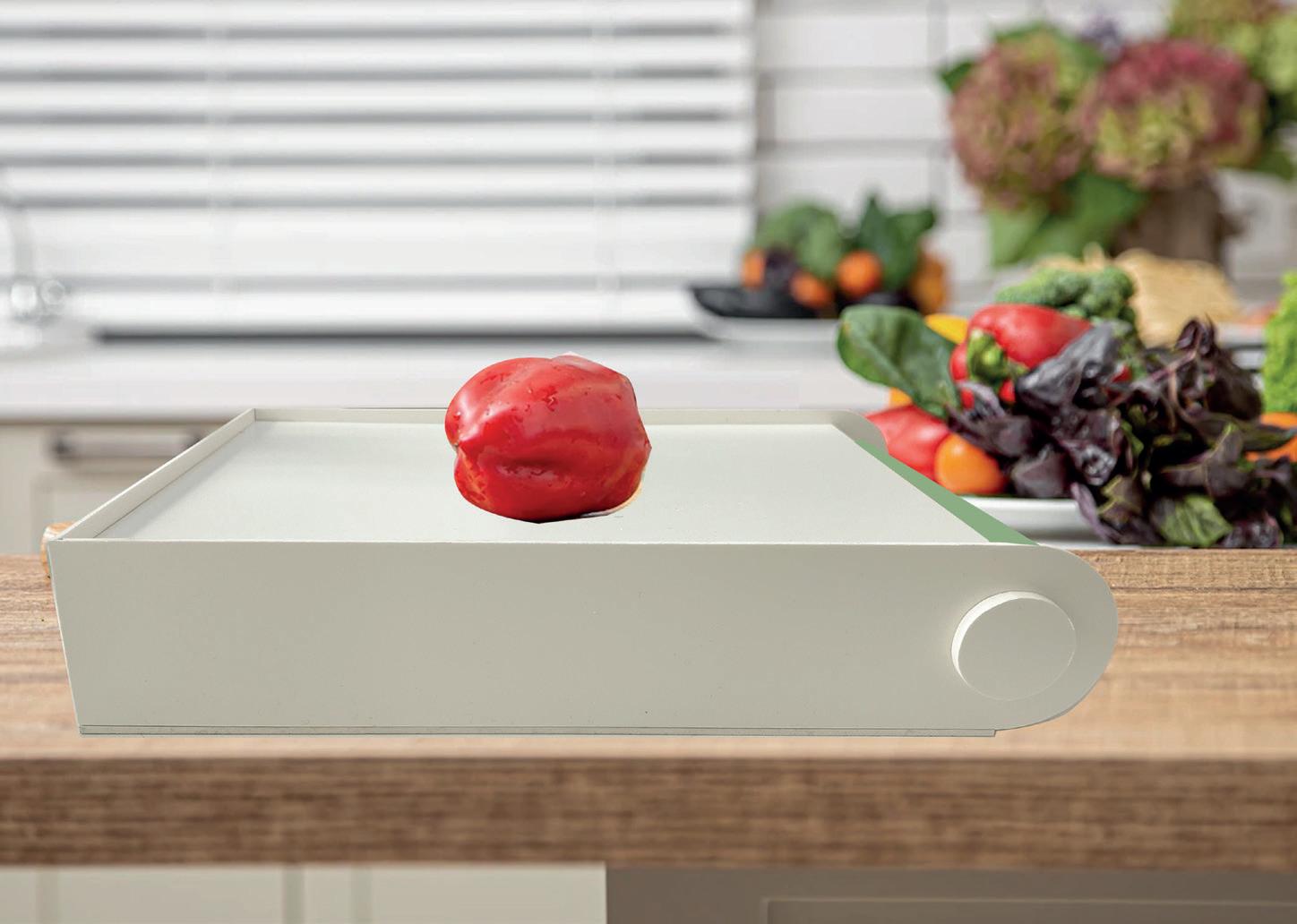

Cover image: Yunxin Ding
Studio photography: Craig Whittet
Design: Kat Loudon and Phoebe Willison
Headline typeface: Rules by Freddie Guthrie

Printed by The Newspaper Club on 80gsm bright recycled newsprint.
All work shown remains the property of the designers and may not be reproduced in print or any other media without written permissions. Contact details for all work is provided on each page for any enquiries.
